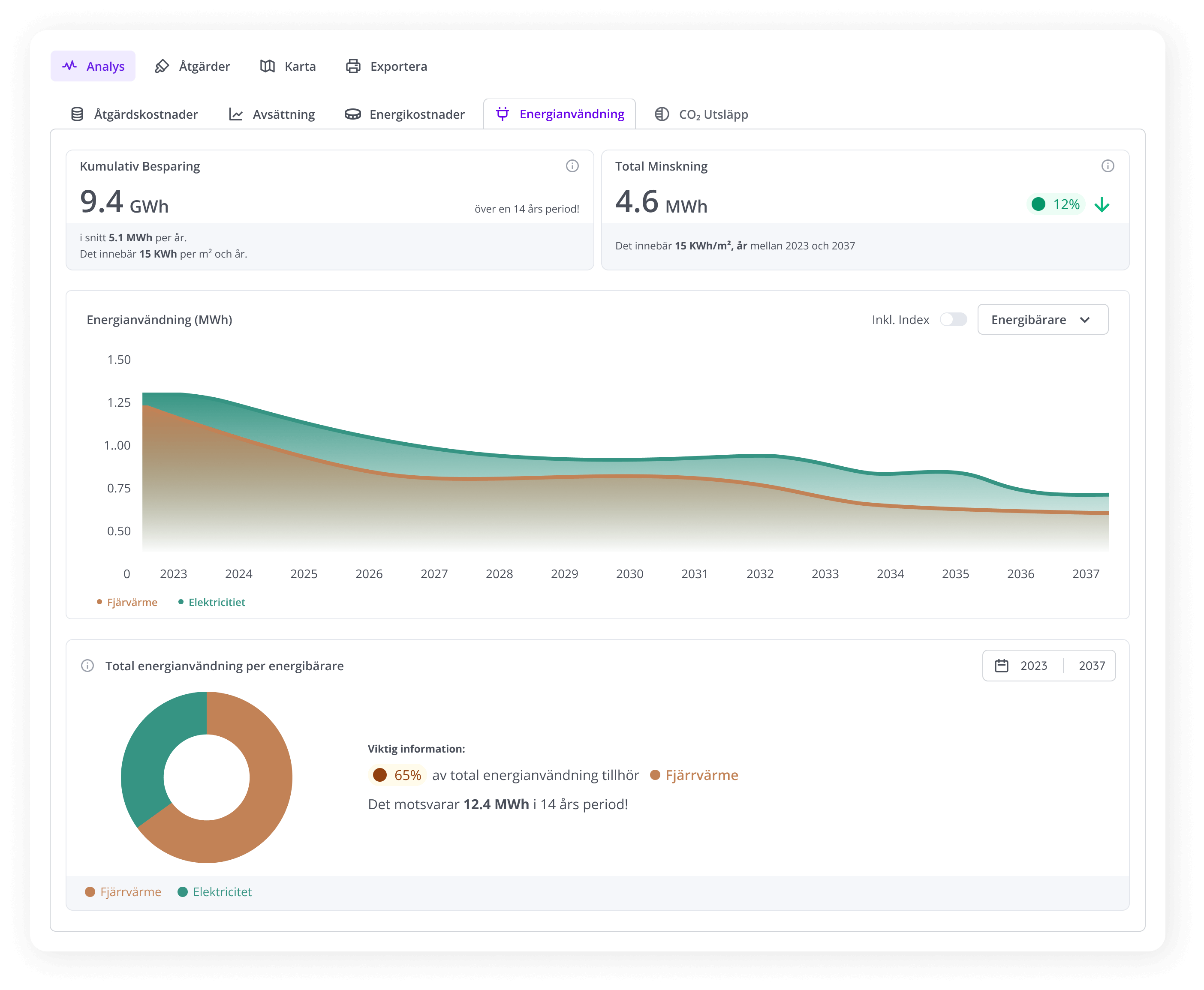Climate-smart maintenance planning - what is it?
Buildings account for almost a quarter of the total energy demand and emissions of greenhouse gases in Sweden. Many properties today need extensive maintenance to meet today's building standards and energy performance requirements. With limited resources and increased energy and material prices, the entire real estate industry faces a challenge when it comes to property maintenance and renovations. In addition to this, national climate and energy targets put additional pressure on property owners to reduce energy needs and carbon dioxide emissions.
This is where climate-smart maintenance planning comes in – as a way to deal with this challenge in the industry. Here we tell you more about climate-smart maintenance planning and why it is more important than ever right now.
First of all, what is a maintenance plan?
A maintenance plan shows all future maintenance and renovation needs for a specific property. A good plan should include what maintenance and renovation needs exist, when they need to be done and how much these actions will cost.
A maintenance plan must answer the following three questions:
- What measures need to be taken in the property?
- When do maintenance and renovations need to be carried out?
- How much will it cost?
In this way, you get an overview of current maintenance needs as well as future costs for maintenance and renovation. By structuring and planning maintenance well in advance, you also reduce the risk of missing important measures which in some cases can mean extensive emergency costs if something happens. This gives you the opportunity to plan long-term, spread costs over several years and at the same time avoid possible cost peaks. With a sustainable and long-term maintenance plan kan du också skapa synergier i underhålls- och renoveringsarbetet. Exempelvis kan du planera in fönsterbyte och fasadmålning samtidigt och på så sätt spara kostnader på byggnadsställningar.

What then is climate-smart maintenance planning and why is it important?
If we now know what a maintenance plan is, then what is a climate-smart maintenance plan? A climate-smart maintenance plan also includes environmental and energy aspects in addition to everything else above. While a maintenance plan is an excellent tool for keeping track of the actions that need to be done in the property, it mainly focuses on the financial perspective: what needs to be done and how much will it cost? But what then happens to the needs around the environment and energy? Climate change and increased requirements for reporting on energy and environmental impact mean that you also need to keep track of environmental and energy needs in maintenance planning – not just financial and technical needs. A climate-smart maintenance plan gives you exactly this.
In the near future, it may e.g. become up-to-date with a minimum requirement regarding energy needs in properties through the new version of Energy Performance of Buildings Directive at the same time as EU-taxonomy sets stricter rules on who can get sustainable financing to finance building renovation projects.
Better basis for decision-making
Another challenge is the time and often large investments that maintenance and renovation projects require, which means that you need to be able to plan long-term in order for the projects to be as time- and cost-effective as possible. If, in addition, energy and environmental needs are to be included in the planning, it becomes even more important to have a good decision-making basis that includes both economic and environmental aspects. This is what climate-smart maintenance planning helps with.
“Create a decision basis based on both economic and environmental aspects – this is when you can prioritize measures from a holistic perspective and work proactively towards energy and climate goals.”
A plan that includes both economic and environmental aspects
While a "normal" maintenance plan gives you an overview of future maintenance and renovation needs as well as costs and investments, a climate-smart maintenance plan contains all this but also the property's future energy and climate impact.
A climate-smart maintenance plan helps you answer the following four questions:
- What measures need to be taken in the property?
- When do maintenance and renovations need to be carried out?
- How much will it cost?
- Hur kommer underhåll och renoveringar påverka energibehov och klimat?
Istället för att enbart fokusera på den ekonomiska prognosen och framtida kostnader för underhåll kan du på detta sätt även få med energibehov och klimatpåverkan i beräkningen. Skapa ett beslutsunderlag baserat på both financial and environmental aspects - this is when you can prioritize measures from an overall perspective and work proactively towards energy and climate goals, but also adapt the planning based on this.
Which scopes should be included in the plan?
What should you then focus on in your climate-smart maintenance plan? Since a climate-smart maintenance plan not only tracks costs but also other indicators related to the building's energy needs, it can be difficult to know what to focus on. Here, it can be smart to adapt to existing reporting standards and monitoring systems. This makes it easier for you to follow up on completed actions. For example, it becomes possible to compare the calculated reduction in energy demand with the actual reduction.
There are several standards for calculating and reporting emissions of greenhouse gases. The most widely used standard for reporting greenhouse gas emissions for businesses is the GHG protocol, where GHG stands for Greenhouse Gas. The GHG protocol distinguishes between three different dimensions of emissions – scope 1, scope 2 and scope 3.
| The three scopes of the GHG protocol | |
|---|---|
| Scope 1 | Direct emissions from your business, such as from burning fossil fuel for heating |
| Scope 2 | Indirect emissions from energy supply such as e.g. electricity and district heating that is consumed in the company's own operations |
| Scope 3 | Indirect emissions that occur in the business value chain but are not owned by your business based on 15 different categories, e.g. residents' electricity consumption or production of building materials |
A climate-smart maintenance plan should at least include scope 1 and 2. These scopes are the easiest to control and can be influenced through various maintenance and renovation measures such as e.g. investments in renewable energy sources such as solar cells.
Scope 3 emissions can be a little more difficult to both calculate and address because they include emissions that are often not under one's direct control, such as purchased goods and services. Many certifications require an assessment of scope 3 emissions and today it is a requirement that emissions from materials and construction are declared for new buildings in climate declarations. Even for existing buildings and properties, the trend is in a direction where scope 3 emissions are becoming increasingly important. If you need guidance on what to focus on when you start reporting on scope 3 emissions, the Property Owners in Sweden have recently published a guidance on reporting scope 3.
Start with direct emission sources
Emission sources that are directly related to planned maintenance actions are a good starting point. For example, emissions from residents' electricity consumption - which, among other things, affected by installing efficient kitchen appliances. Or production of used materials in maintenance and renovation projects. Especially the climate impact that occurs during construction projects has a large impact on the total climate impact of buildings during their lifetime.
If you want to get started with assessing emissions from materials and construction, the Environmental Product Declarations (EPD) and the Housing Authority's climate database for climate declarations are good resources.

climate-smart maintenance plan that includes scope 1 and 2 based on Sinom's algorithm
Climate-smart maintenance planning with Sinom
We think it should be just as easy to keep track of energy and climate aspects in maintenance planning as it is to keep track of costs. That is why Sinom combines a financial overview with calculations of the property's future energy and climate impact. You get a clear overview and can make smart decisions about measures that need to be taken, not only based on what they cost, but also based on their effect on the climate and environment.
By using the tool's smart planning functions, you can ensure that you reach your energy and climate goals. Sinom can e.g. advance measures in time that need to be implemented earlier to reach specific emission targets.
Do you want to know more about how you can get started with climate-smart maintenance planning in our digital system for property maintenance and maintenance planning? Contact us here or book a demo.
Share:
More interesting blog articles:

Bortom datapunkter: Hur Sinom väcker byggnader till liv i sitt planeringsverktyg
I dagens digitala tidsålder samlas mer och mer data. Men det handlar inte bara om att samla datapunkter; det handlar om att göra dem meningsfulla,

How energy efficient are your properties?
Do you know how energy efficient your properties really are? And did you know that there are rules regarding energy management when you are going to build a new or

Work systematically towards the global sustainability goals together with Sinom
We work for well-maintained properties and a better world. We live in a society where many of our resources are not used sustainably

This is how you make a sustainable and long-term maintenance plan
As a property owner, you have an obligation to maintain the buildings and properties you own. You need to ensure that the building is preserved in a good technical condition

What is data-driven maintenance planning and how does it work?
A property owner has an obligation to maintain buildings and properties in order to preserve them in good condition. To make this possible, many people use

